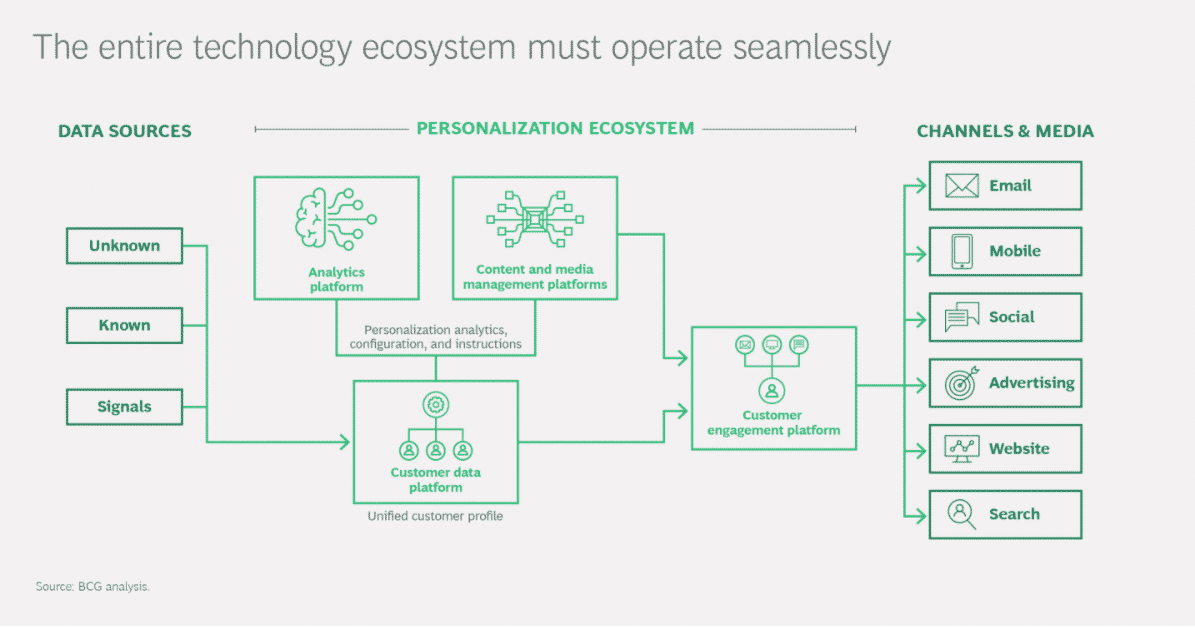
The ability of brands to personalize content has evolved over the years. However, the appetite for content personalization has gone ludicrous with customer demands for more tailored engagements.
According to an article published by the Boston Consulting Group, marketers will have to produce content as individual components that can be sophisticatedly combined, going beyond simple tag replacements like Hi John to Hi Jane.
So, how can marketers win the race for personalization?
The simple answer is atomic personalization.
Atoms form molecules – molecules are placed in different combinations – to form different matters. Atomic personalization works on the same principle.
Atomic personalization involves breaking down content into small components of content – ready to be customized at scale. It provides personalization at an individual level: both at the point of interaction and channel.
Change is never easy especially when it comes to your marketing strategy. So, why pivot?
Marketers know all too well just how flaky the market gets. The best marketing strategy is to be the first one at everything. In this post, we have built an actionable case for why marketers should use atomic personalization.
Atomic personalization takes your static marketing campaign to a whole different level by creating multiple variations of content and adapting it to fit the destination.
Creating multiple variations of content allows marketers to deploy different formats, backgrounds, image variations to different customers. As a result, each creative asset ends up being unique for the individual customer, making it a personalized and contextualized experience at the point of interaction.
Adapting content to fit the destination makes it easy for marketers to produce multiple variations of the same content for different channels. For instance, create different creative asset dimensions to complement the ad image specs for Facebook, Twitter, LinkedIn, etc.
Instead of creating entirely new creative assets, the concept of atomic content breaks down content into logical parts – the dynamic “atoms” – this includes geolocation-based images, videos, offers, call to action, inventory-adjusted recommendations, and dynamic mirroring of the website.
Atomic content enables the dynamic assembly of small, modular elements of content and media that makes for a rich content library. Essentially, the atomic content library can be conjured and assembled on the go based on context, customer data, and business logic.
Moreover, each atomic unit has a unique URL that can be stored in the page cache and repurposed for all users in the same user segment. This allows your marketing team to deliver engaging customer experiences by adopting a unified approach to managing the entire lifecycle of creative assets.
Atomic personalization brings efficiency and enhances creative asset production at scale. The very fact that marketers do not have to spend a chunk of time on creating assets manually, reduces the time to launch marketing campaigns.
Bonus Tip: Ensure that all members of your marketing organization have the same updated versions. It means one link to track updates and the history of each creative in real-time, ensuring everybody is on the same page.
Atomic personalizations provide opportunities to adopt a flexible and best-in-class modular technology, leading to a multiplatform marketing tech stack. The new and improved stack ensures that you can accommodate changes on such modularity, helping you meet all your personalization goals.
The advanced marketing tech stack allows marketers to store and segment data, compile consumer profiles, and help target audiences across relevant channels. Moreover, marketers can use analytics to identify and fulfill personalization requirements to ensure tailored creative assets are deployed without interruption.
Savvy marketers use customer data platforms(CDP) to create a centralized hub for customer data. It uses the data collected to create customer profiles. The profiles help identify the behavior of individual customers across all channels and devices. Marketers can feed relevant ads to the right prospects at the right places in real-time, increasing lead acquisition scores.
However, analyzing all of this data and deriving insights from it is easier said than done. You need to be able to do it all to perfection to personalize your campaigns better. For this purpose, we recommend hiring a person with a degree in data science to help you. They would have the skills needed to understand all that big data on your customers and derive insights from it.
The content platform will enable marketers to assemble pieces of content in different forms and shapes to personalize the creative production for each customer at the point of interaction. You can view the health of the creative asset lifecycle by comparing the internal content production metrics with actual consumption. It helps marketers to prioritize content creation, increasing production efficiency while saving time.
Manual content creation at such a granular level can strain your marketing process. Hence, creative automation. Produce highly-targeted contextual creative assets like banner ads and videos at scale, reducing costs and better ROI on your campaign.
Measure engagement metrics and apply the knowledge to improve the impact of the creative assets. This knowledge will empower not only marketers but other cross-functional teams like data scientists and developers.
AI-powered hyper-personalization provides a nuanced understanding of individual customers and aligns content with their respective needs. AI applications like predictive analytics and user behavior reporting are just some of the ways brands can raise the bar for customer engagement. A good example is Amazon Advertising. The eCommerce giant’s ad platform allows marketers to create a unique, hyper-personalized ad experience for shoppers.
Pivot your personalization efforts and production budget based on what is working for you. Complicated strings of data are communicated through a flexible and scalable system.
Implement A/B testing aka split testing to test multiple variations of your ad copy at once. It strips out any possible ad fatigue which hampers campaign performance. Without testing you’d never know – you can get the same results for two different ads but you may be paying $2 per click for one variation and $1 per click for another. There’s no need to second guess anything when you are constantly testing to understand consumer reactions.
The marketing tech stack infused with atomic content will create the perfect personalization ecosystem.

Dynamic creative uses consumer data to create the graphical attributes in ad creatives. It includes data on products viewed, display timestamps, and geolocation. While dynamic creative optimization (DCO) combines creatives with personalized data.
Atomic personalization takes it up a notch. Marketers can break down larger pieces of creatives into smaller bits that can be put together in multiple combinations, enabling creative production at scale. Instead of creating eight personalized versions of a long-form video, you can personalize smaller component pieces of that video, drastically cutting down production overheads.
Traditionally, businesses that offered personalization found some level of marketing success. Moving forward, marketers who can offer sustainable and cohesive granular personalization, in the context of the overall user journey, will be met with prosperity.
Atomic personalization provides the right knowledge that helps marketers select the best combination of modular components and combine them in the best set of permutations and combinations. The effortless technique of turning modular assets into personalized images on the fly accelerates personalization while easing the workload of your design team.
Brands that quickly develop the capability of atomic personalization – bringing together new content variations, effective media management practices and technology, and advanced analytics – will be able to build strong customer relationships that will be difficult for late adopters to break.
Ultimately, delivering individually relevant content at scale will be the new marketing frontier.